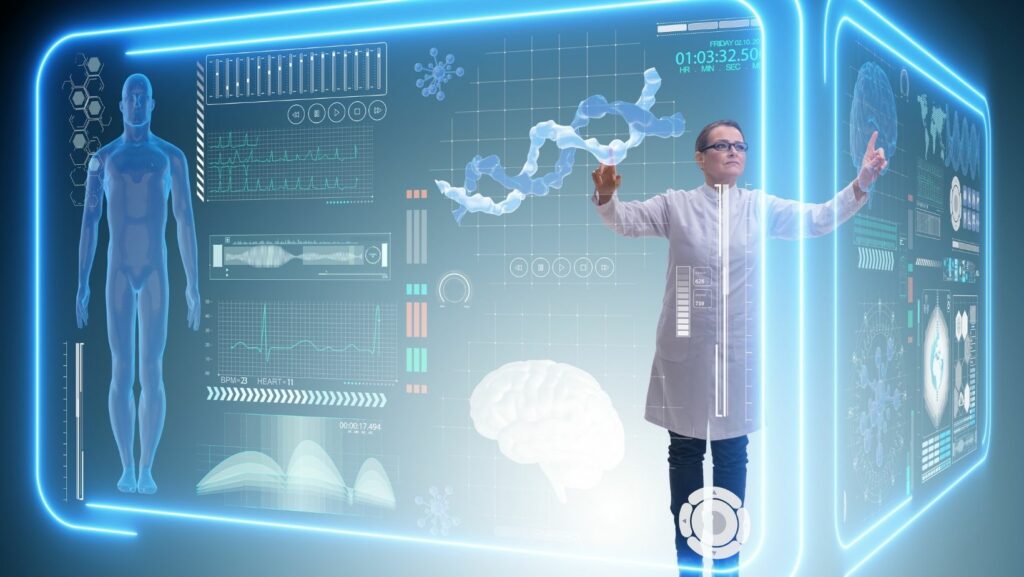Chronic diseases affect a significant portion of the global population and pose a major public health challenge.
The CDC reports that 60% of American adults live with at least one chronic disease, and 40% have two or more. These conditions, including cancer, heart disease, and diabetes, are the nation’s leading causes of death and disability, accounting for $4.5 trillion in annual healthcare expenditures.
Managing these diseases requires continuous monitoring and regular medical consultations. However, traditional methods can be cumbersome and inefficient, often leading to poor patient engagement and suboptimal health outcomes.
The rise of digital health solutions presents a promising alternative to traditional chronic disease management. These technologies enhance connectivity between patients and healthcare providers, allowing for more efficient communication and timely medical interventions.
Remote Patient Monitoring (RPM): A Key Component
A remote patient monitoring platform can play a crucial role in modern chronic disease management. It allows healthcare providers to track patient health in real time without requiring frequent in-person visits. These platforms monitor vital signs, symptoms, and key health metrics for conditions like diabetes, heart disease, and chronic respiratory disorders, ensuring timely medical intervention.
According to CoachCare, whether at home, work, or even on vacation, patients can easily report their health data, closing the gap between office visits. With remote patient monitoring software, providers gain continuous access to patient data, enabling proactive care.
Beyond basic data collection, advanced RPM platforms leverage AI to detect trends, predict complications, and issue alerts for concerning changes. This predictive approach allows for early intervention, reducing hospitalizations and improving patient outcomes. In today’s digital age, RPM technology enhances patient engagement, empowers providers, and optimizes healthcare efficiency.
Remote Healthcare Monitoring: Bridging Care Gaps
Remote healthcare monitoring systems enhance the capabilities of RPM platforms by creating a comprehensive framework for ongoing patient care. These systems enable regular communication between patients and healthcare providers through secure video consultations, messaging platforms, and automated check-ins.
For individuals managing chronic diseases, this constant connection to their healthcare team offers reassurance and immediate access to medical guidance when needed.
The integration of remote healthcare monitoring has proven particularly effective for conditions that require frequent adjustments to treatment plans. For example, patients with chronic pain can report symptom changes in real-time, allowing their healthcare providers to promptly modify interventions. This responsiveness enhances outcomes and promotes collaborative, engaged healthcare.
Electronic Health Records: Streamlining Information Management
Electronic Health Records (EHR) have transformed chronic disease management by creating a centralized hub for patient information. These digital systems enable seamless documentation of clinical findings and treatment plans and facilitate information sharing across healthcare settings.

The CHRONICLE initiative, a Chronic Disease Registry that links data from EHRs, showcases the potential of using EHRs for chronic disease surveillance. By collaborating with statewide Health Information Exchange networks, CHRONICLE enables the development of evidence-based strategies and precise disease monitoring.
Analyzing EHR data within this system allows healthcare organizations to spot trends in population health and refine their treatment protocols for improved patient care.
Modern EHR systems incorporate patient portals, allowing individuals to access their health information, schedule appointments, and communicate with providers. The system’s clinical decision support features provide timely alerts about medication interactions and necessary follow-ups.
Through systematic testing and evaluation, EHR systems continue to evolve, supporting more effective resource allocation and comprehensive disease surveillance.
Mobile Health Applications: Empowering Patients
Mobile health (mHealth) applications are transforming chronic disease management by empowering patients to actively participate in their care. These apps allow individuals to track symptoms, medications, and lifestyle choices directly from their smartphones, often providing valuable educational resources about specific conditions.
Furthermore, AI-powered mHealth apps, as highlighted by ResearchGate, offer significant benefits by providing personalized, timely interventions and continuous monitoring.
These intelligent applications can enhance patient engagement through real-time feedback and tailored recommendations, promoting more effective self-management. Critically, AI-driven apps have the potential to reduce healthcare costs by facilitating early intervention and preventing complications, thus avoiding expensive hospitalizations.
They can also optimize resource allocation by identifying high-risk patients needing intensive management while supporting lower-risk individuals with automated guidance.
Wearable Technology: Continuous Monitoring
Wearable devices are transforming how chronic diseases are managed by offering continuous, real-time health insights. Fitness trackers, smartwatches, and similar technologies gather valuable data on various metrics, including physical activity levels, heart rate variability, and sleep patterns. This empowers both patients and their healthcare providers with actionable information.
As highlighted by TechTarget, this shift from episodic clinic visits to continuous data access is transformative. Wearables enable the early detection of subtle changes in a patient’s condition, potentially preventing critical events.
Furthermore, many wearables incorporate gamification elements to motivate users to achieve fitness goals and maintain healthy behaviors. A 2022 survey revealed that a significant majority of users track metrics like pulse rate, calories, heart health, and sleep quality. They primarily do so to count steps, motivate exercise, and track weight loss.
Importantly, a large proportion of users believe these devices have positively impacted their fitness and health, with many reporting significant improvements.
Frequently Asked Questions
How do Digital Health Solutions Improve Medication Adherence in Chronic Disease Patients?
Digital health solutions improve medication adherence through automated reminders, real-time tracking of medication intake, and feedback systems that notify about missed doses.

These tools can also provide educational content about medications and their importance, helping patients understand why adherence is crucial for managing their condition effectively.
What Types of Chronic Conditions Benefit Most from Remote Monitoring?
Remote monitoring benefits various chronic conditions. It has shown particular effectiveness in managing diabetes, cardiovascular diseases, chronic obstructive pulmonary disease (COPD), and hypertension. These conditions require regular monitoring of specific health parameters and can benefit from early intervention when measurements fall outside normal ranges.
Are Digital Health Solutions Accessible to Older Patients Who May be Less Technologically Savvy?
Digital health solutions are increasingly designed with user-friendly interfaces that accommodate users of all technological skill levels. Many platforms offer simplified versions for older patients, and healthcare providers typically provide training to ensure patients can effectively use these tools.
Digital health is revolutionizing chronic disease care by improving access to healthcare, increasing patient involvement, and facilitating timely interventions. While challenges remain in widespread adoption and implementation, the potential benefits for patients and healthcare providers are significant.
As technology evolves, integrating these innovations will be essential for enhancing chronic disease management outcomes worldwide.



